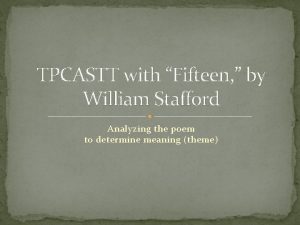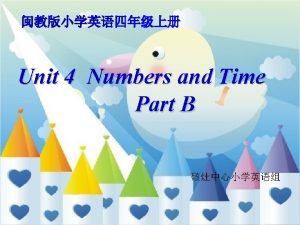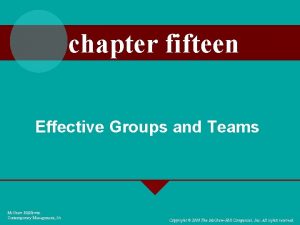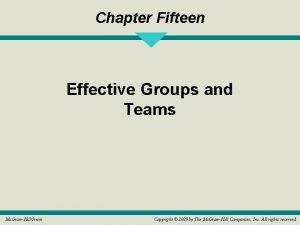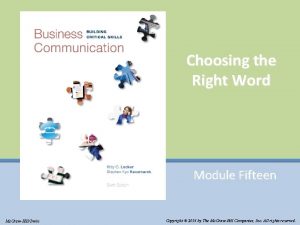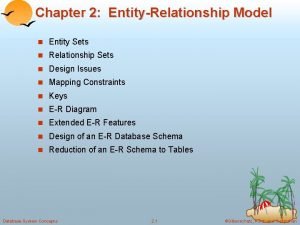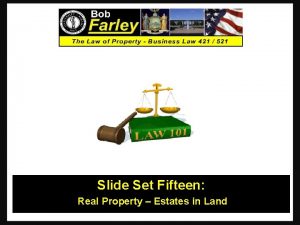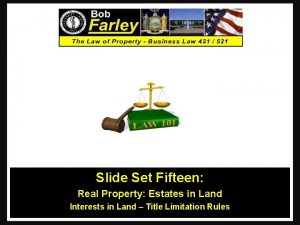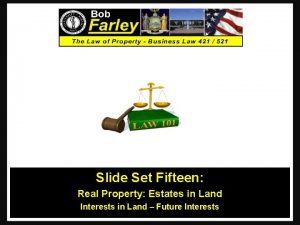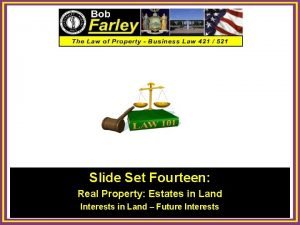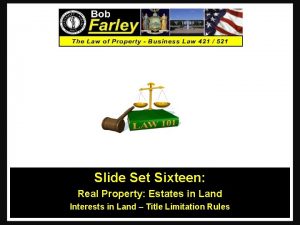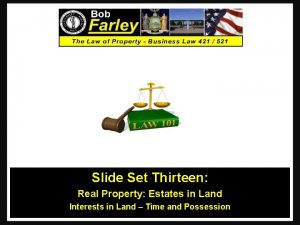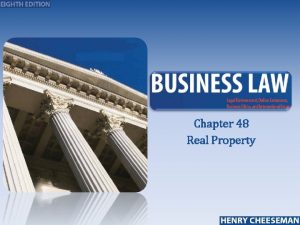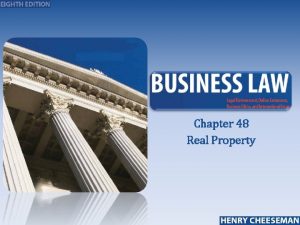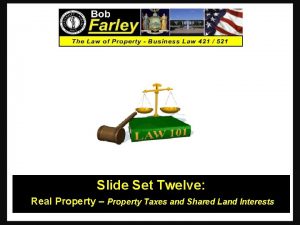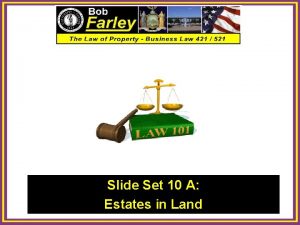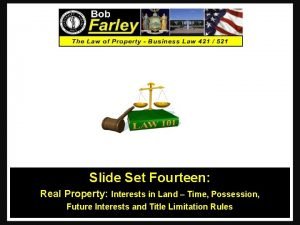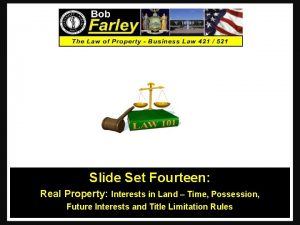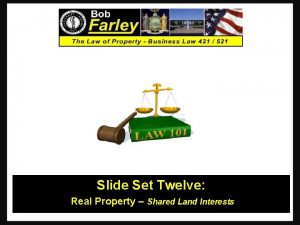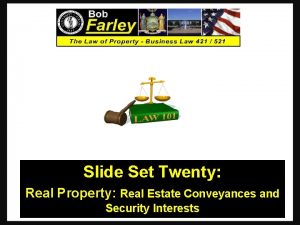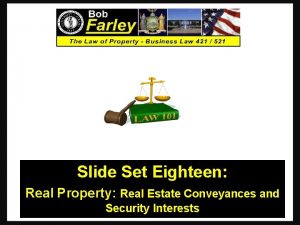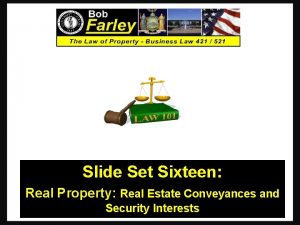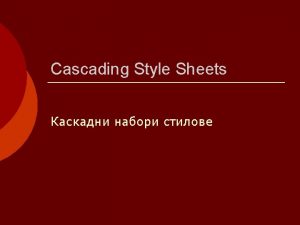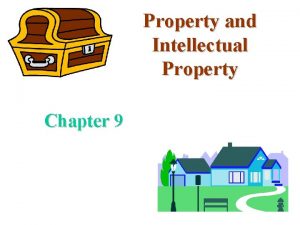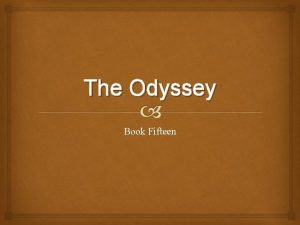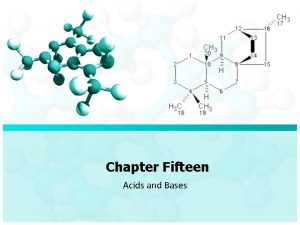Slide Set Fifteen Real Property Estates in Land


























- Slides: 26

Slide Set Fifteen: Real Property: Estates in Land Interests in Land – Title Limitation Rules 1

Last Class: • We Discussed: - The Nature, Definitions and Explanation of Estates in Land - Future Interests - Estates in Time 1. Life Estates, 2. Possibility of Reverters, and 3. Rights of Re-Entry 2

Tonight’s Class • We Will Discuss: - The Nature, Definitions and Explanation of Estates in Land - Title Limitation Rules - Rule in Shelley’s Case - Doctrine of Worthier Title - Rule Against Perpetuities - Rule Against Restraints on Alienation 3

Title Limitation Rules 4

Title Limitation Rules • • Rule in Shelley’s Case Doctrine of Worthier Title Rule Against Perpetuities Rule Against Restraints on Alienation These Rules All Seek to Promote Marketable Title and Ensure that Real Property is NOT Controlled for any significant time from Beyond the Grave 5

RULE IN SHELLY’S CASE • Wolfe v. Shelley, 1 Co. Rep. 93 b, 76 Eng. Rep. 206 (C. P. ), generally known as Shelley's Case • In 1581 England, in an attempt to avoid inheritance taxes, land transactions were being structured: To A for life, with a remainder to A’s heirs • Seeing through this legal fiction, the court held that since A could control the disposition of his estate (i. e. who would be his heirs), that any such transfer was really, and should be deemed to be: Now: To A in Fee Simple Absolute. 6

The Rule in Shelley’s Case As a Result: • If a life estate is created in A and a remainder is created in A’s heirs, the remainder is deemed to have been created in A rather than A’s heirs. • Now with the Rule in Shelley’s Case, A would have a life estate and the next vested estate, and they would merge to give A a fee simple absolute in the property. • Reasons for the rule? - Promote marketable title - End a legal fiction tax dodge 7

Doctrine of Worthier Title (Similar to Rule in Shelley’s Case, but with different parties) • Again in Common Law England, in an attempt to avoid inheritance taxes, land transactions were being structured: To A for life, with a remainder to O’s heirs • Seeing through this legal fiction, the courts held that since O could control the disposition of his estate (i. e. who would be his heirs), that any such transfer was really, and should be deemed to be: Now: To A for Life, with a Reversion to O. 8

Rule Against Perpetuities • The Rule Against Perpetuities is one of the most complicated Rules in the Law. Basically, common law disfavors and prevents property from being held perpetually in trust. 9

The Rule Against Perpetuities Statement of the Rule: • Any agreement with respect to the transfer of property (reversions, remainder, ect. ) is VOID which does not end twenty-one (21) years after a life in being at the time of the transfer (i. e. one generation from lives presently in being twenty-one years. ) 10

Rule Against Perpetuities Another way to describe this is: "No property interest shall be deemed valid unless it vests, if at all, not later than 21 years after some life in being at the time of the creation of the interest. “ An interest is "vested" when we know for sure that someone will receive, or fail to receive, the interest. 11

The Rule Against Perpetuities Explained: • This 21 years (which represents a generation) is an arbitrary time period merely intended as a breaker for the entanglement to estates and their title, so as to return such estates back to the preferred title of fee simple absolute. 12

The Rule Against Perpetuities Pursuant to this Rule “lives in being” include: 1. The holder of the interest; 2. The person creating the interest; 3. Any person who can affect a condition precedent attached to the interest; and 4. Any person who can affect the identify of the holder It should be noted that unborn babies, if born alive, are considered “lives in being” 13

The Rule Against Perpetuities 14

Rule Against Restraints on Alienation • This Rule was established and recognized under Common Law. It stated that: “Any restriction on the transferability of a legal (as distinguished from an equitable) interest in property is, and shall be deemed as, void. ” • A “Restraint on Alienation" means an express restriction on the future transferability of the real property. • Like the Rule Against Perpetuities, this is a Rule of public policy, that is designed to encourage the marketability of title, and prevent real property from being tied up and taken out of commerce. 15

Rule Against Restraints on Alienation There are three types of restraints on alienation: 1. Disabling restraints, which prohibit any future transfer; 2. Forfeiture restraints, under which an attempted transfer results in a forfeiture of the interest; and 3. Promissory restraints, under which an attempted transfer breaches a covenant. 16

Rule Against Restraints on Alienation Types of Restraints • ALL Disabling Restraints on Legal Interests Are VOID - Disabling restraints are seen as particularly offensive because: (i) Unlike the other types of restraints, transfers are totally prohibited; (ii) they enable a person to deny the validity of his own conveyance, and (iii) they exempt the property from the person's creditors even while he is enjoying the property. • ALL Absolute Restraints on Fee Simple Are VOID - Absolute restraints of whatever type on fee simple estates are void. - The grantee may ignore the restraint and freely transfer the property. 17

Rule Against Restraints on Alienation Exceptions to the Rule: • Partial Restraints on Fees Simple - Although absolute restraints on fee simple estates are held to be VOID, a restraint for a limited time and for a reasonable purpose is likely to be upheld. • Example and Explanation: A owns and resides in a house. He conveys a one-half interest in the house to his brother, B, including in the deed, a covenant that "during their joint lifetimes, each party promises not to convey his interest to any other person without the consent of the other party. " This promissory restraint is limited to the joint lifetimes of the parties and is a reasonable way to ensure that neither party will be faced with the prospect of having to reside with a stranger. This restraint would probably be upheld. 18

Rule Against Restraints on Alienation Exceptions to the Rule Continued: Forfeiture and Promissory Restraints on Life Estates Forfeiture and promissory restraints on life estates are VALID. A life estate is inalienable as a practical matter because few would be willing to pay full value for an estate of uncertain duration. As a result, little is lost by giving effect to the transferor's intention to restrict the estate's transferability. (However, Disabling restraints on legal life estates are void. ) 19

Rule Against Restraints on Alienation Exceptions to the Rule Continued: • Forfeiture Restraint on Transferability of a Future Interest A forfeiture restraint on the transferability of a future interest, during the period when the interest is still a future interest, is deemed to be VALID. 20

Rule Against Restraints on Alienation Exceptions to the Rule Continued: • Reasonable Restrictions in Commercial Transactions The courts tend to uphold restrictions on transferability that arise in the context of a commercial transaction on theory that the restriction appears in an agreement entered into by the parties, it is a product of their bargaining, and presumably serves a useful purpose in facilitating the parties' objectives. Thus, restrictions on transferability that are part of a bargained for agreement, as distinguished from a donative transaction, are deemed valid. 21

Rule Against Restraints on Alienation Exceptions to the Rule Continued: • Right of First Refusal The right to have the first opportunity to purchase Real Estate when it becomes available, or the right to meet any other offer, is valid if reasonable. ( i. e by specifying fair market value or other reasonable price). 22

Rule Against Restraints on Alienation Exceptions to the Rule Continued: • Restrictions on Transferability of Leaseholds A provision in a lease prohibiting the lessee's assignment or subletting of their leasehold interest without the consent of the landlord is given effect in all jurisdictions. • Spendthrift Clauses Are Valid The rule applicable to restrictions on alienation involving equitable interests (i. e. those held in trust) is the exact opposite of legal interests. As a result, Spendthrift clauses, which are true disabling restraints, are deemed VALID. 23

Title Limitation Rules • • Rule in Shelley’s Case Doctrine of Worthier Title Rule Against Perpetuities Rule Against Restraints on Alienation These Rules All Seek to Promote Marketable Title and Ensure that Real Property is NOT Controlled for any significant time from Beyond the Grave 24

Class Exercise: The Case of the Ski-slope The Club and the Rope Tow 25

• Bonus Questions of the Day For next time – Read Assignments for Class One to Eighteen • Questions? ? ? 26
 Basic dance steps in heel and toe polka
Basic dance steps in heel and toe polka Total set awareness set consideration set
Total set awareness set consideration set Training set validation set test set
Training set validation set test set Fifteen william stafford analysis
Fifteen william stafford analysis One two three four five six numbers
One two three four five six numbers Fifteen by william stafford
Fifteen by william stafford Purdue owl subject verb agreement
Purdue owl subject verb agreement Dynaway software
Dynaway software Team fifteen mc
Team fifteen mc Types of task interdependence
Types of task interdependence 15 departments of the cabinet
15 departments of the cabinet Fifteen mc
Fifteen mc An area of land largely enclosed by higher land
An area of land largely enclosed by higher land High rocky land usually with steep sides
High rocky land usually with steep sides Commutative vs associative
Commutative vs associative Doctrine of blending
Doctrine of blending Chemical property definition
Chemical property definition The descriptive property possessed by each entity set is
The descriptive property possessed by each entity set is Factoring checklist
Factoring checklist Bounded set vs centered set
Bounded set vs centered set Fucntions
Fucntions Crisp set vs fuzzy set
Crisp set vs fuzzy set Crisp set vs fuzzy set
Crisp set vs fuzzy set What is the overlap of data set 1 and data set 2?
What is the overlap of data set 1 and data set 2? Surjective vs injective
Surjective vs injective Commutative property of multiplication
Commutative property of multiplication Immobility real estate
Immobility real estate



